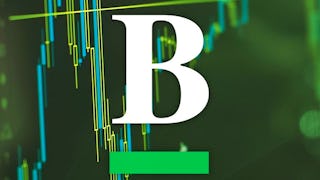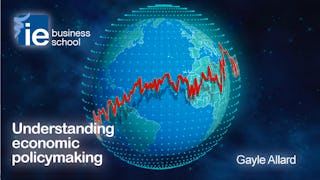This MOOC prepares students that want to analyse trade and investment policies of developing countries and emerging markets. We couch you for the task of giving evidence-based policy. For students interested in policy advise the course brings a sound understanding of what can and what cannot be done with well-established theories and state-of-the-art research. For students interested in research the asset of this course is to learn how to effectively communicate research findings in a policy setting.


Trade & investment: evidence-based policies for development



Instructors: Peter A.G. van Bergeijk
5,171 already enrolled
Included with
(21 reviews)
Skills you'll gain
Details to know

Add to your LinkedIn profile
See how employees at top companies are mastering in-demand skills

There are 5 modules in this course
After the first week (5 video lectures), you will understand key concepts and theories of international trade and foreign direct investment (FDI) and describe recent trends in the world economy. With the debate over (de)globalization and development as our starting point, we analyze how (changes in) the economic context drive the formulation of new trade theories. We will discuss both mainstream and a selection of heterodox approaches. We explore concepts and theories related to FDI, provide an overview of FDI effects for host countries and discuss theories explaining investment activities across national boundaries.
What's included
5 videos7 readings1 assignment1 discussion prompt
After the second week (4 video lectures) you will be able to identify national policies aimed at either stimulating or restricting international trade and investment. We discuss policies and instruments against the background of recent developments and provide context to the importance of negotiations and treaties that deal with policy instruments. You will be able to analyse where the use of bilateral economic diplomacy in state-to-state relationships can help to assist domestic companies as encounter difficulties abroad and where the contribution of economic diplomats is limited
What's included
4 videos4 readings1 assignment
After the third block (3 video lectures) you will understand the nature of internationalization, heterogeneity, and development from a micro-economic perspective. We will discuss productivity development of firms and their decision to export and import and deal with access to detailed and reliable micro-economic data sets. You will understand the microeconomic underpinnings of globalization and productivity and the process of measuring productivity development and firm heterogeneity. You will also be able to evaluate the relationship between productivity and international trade and FDI and understand the relevance of heterogeneity across firms and their productivity development and interpret their results.
What's included
3 videos3 readings1 assignment
After the fourth block (4 video lectures) you will understand analytical tools and gravity modelling dealing with evaluation of trade and/or investment policies. The Block starts with Balassa’s index of revealed comparative advantage, the Herfindahl Hirschman concentration index, and the Grubel Lloyd index that measures intra-industry trade. You will be able to apply these indicators and relate them to real-world trade issues. Next, we discuss the historical development of the gravity model, which was originally developed in the Netherlands. Finally, you will be able to evaluate challenges and propose solutions to obtain reliable estimates of gravity modelling. Building on solutions proposed to avoid empirical gravity estimation biases, you will experience and experiment with evaluations of trade policies, dealing with time and cost of border documentation and processing for exporting and importing.
What's included
4 videos4 readings1 assignment
The fifth week (3 video lectures) prepares you for actually writing a policy paper that is both accessible to policy makers, and evidence-based. We start with an overview of controversies regarding international trade and investment because policy advice needs to take a holistic view and a policy paper cannot be sound when only the benefits of considered measures are discussed. You will learn the five do’s of giving advice and how to effectively inform policy makers of scientific findings regarding trade and investment.
What's included
3 videos2 readings1 peer review
Instructors


Offered by
Explore more from Economics
 Status: Preview
Status: PreviewUniversità di Napoli Federico II
 Status: Preview
Status: PreviewO.P. Jindal Global University
 Status: Free Trial
Status: Free TrialIE Business School
 Status: Free Trial
Status: Free TrialIE Business School
Why people choose Coursera for their career




Learner reviews
21 reviews
- 5 stars
85.71%
- 4 stars
9.52%
- 3 stars
0%
- 2 stars
4.76%
- 1 star
0%
Showing 3 of 21
Reviewed on Jan 8, 2023
Top class. I recommend it to anyone studying on the subject trade, investment or evidence-based policy

Open new doors with Coursera Plus
Unlimited access to 10,000+ world-class courses, hands-on projects, and job-ready certificate programs - all included in your subscription
Advance your career with an online degree
Earn a degree from world-class universities - 100% online
Join over 3,400 global companies that choose Coursera for Business
Upskill your employees to excel in the digital economy
Frequently asked questions
To access the course materials, assignments and to earn a Certificate, you will need to purchase the Certificate experience when you enroll in a course. You can try a Free Trial instead, or apply for Financial Aid. The course may offer 'Full Course, No Certificate' instead. This option lets you see all course materials, submit required assessments, and get a final grade. This also means that you will not be able to purchase a Certificate experience.
When you purchase a Certificate you get access to all course materials, including graded assignments. Upon completing the course, your electronic Certificate will be added to your Accomplishments page - from there, you can print your Certificate or add it to your LinkedIn profile.
Yes. In select learning programs, you can apply for financial aid or a scholarship if you can’t afford the enrollment fee. If fin aid or scholarship is available for your learning program selection, you’ll find a link to apply on the description page.
More questions
Financial aid available,
¹ Some assignments in this course are AI-graded. For these assignments, your data will be used in accordance with Coursera's Privacy Notice.

